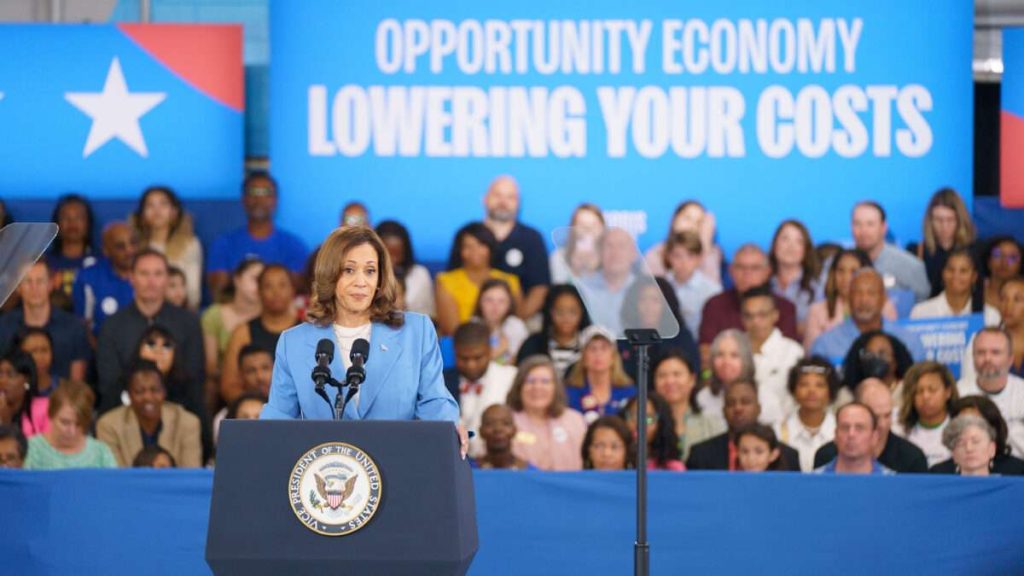If there’s one thing the last 50 years of American politics have proven, it’s that voters hate inflation. If there’s another, it’s that politicians seeking to capitalize on that hatred will propose unproductive, unworkable, and unaffordable policies to counter rising prices.
So it is with Vice President Kamala Harris.
In the weeks since she ascended to the top of the Democratic presidential ticket, Harris has come forward with a suite of policies she has cast as tools for bringing down the cost of living for middle-class Americans. Among those policies are a vague but potentially sweeping federal ban on price gouging for food and groceries, and a subsidy of up to $25,000 for qualified first-time home buyers.
In other words—price regulations and subsidies. History shows that these sorts of policies, which attempt to control market outcomes via top-down federal control, rarely work. And in many cases, they can lead to price hikes and shortages, exactly the opposite of what Harris promises.
Harris isn’t wrong, however, to focus on the high cost of living, especially for middle-class essentials like health care, housing, and education. Even with inflation cooling somewhat, there really is an affordability crisis.
Yet it’s a crisis that a long history of government interventions has failed to fix, or exacerbated. Americans deserve a policy agenda that is credibly aimed at eliminating the government-determined market distortions that have made the crisis so acute.
It’s easy to see why Harris has trained her economic agenda on middle-class affordability. Throughout Joe Biden’s presidency, Americans have consistently rated inflation and the economy as top political priorities. They have given Harris’ GOP rival, former President Donald Trump, an edge on economic issues. (If nothing else, her agenda and messaging have proven she can read the room—or at least the polls.)
On the campaign trail, Trump has sought to exploit that edge, arguing that he left Biden an economic “miracle” that the Democratic administration squandered, glossing over the economic turmoil he presided over during the pandemic year of 2020.
Harris’ proposals, however, leave much to be desired. Consider her proposed ban on grocery price gouging.
At best, it’s totally unnecessary: Food price inflation has dropped dramatically from its peak, and grocery store profit margins are already slim—net margins were just 1.6 percent in 2023.
Defenders have argued that it’s merely a more aggressive form of antitrust enforcement, effectively toothless outside of rare emergencies.
The Harris camp has declined to provide details about how the policy would work, suggesting that it may be more of a messaging strategy than a substantive policy intended to be implemented.
But fundamentally, it looks a lot like other plans to enforce price ceilings by government decree. And in the aftermath of the pandemic years, in which supposedly emergency policies became quasi-permanent, it’s easy to see how such a policy could, in practice, turn out to be a de facto set of federal price controls that stretch throughout the economy.
Harris wouldn’t be the first president to implement a sweeping system of price controls in response to rising inflation.
In the summer of 1971, President Richard Nixon issued an executive order implementing a 90-day freeze on wage and price increases, which he pitched as a way to halt inflation, particularly for groceries. Nixon’s temporary wage and price controls weren’t precisely comparable to what Harris is proposing, but they offer a lesson in the efficacy of even the most aggressive government efforts to cap price hikes.
In the years that followed Nixon’s order, Americans faced long lines for gas, paying for things with time rather than cash. There were shortages of critical goods like steel that gummed up the economy and made life miserable for the middle class. Nor was inflation tamed.
By the late 1970s, under President Jimmy Carter, annual inflation shot up to 12 percent. In an October 1980 debate with his Republican opponent, Ronald Reagan, Carter defended his economic record by noting that inflation had come down from its peak. He touted his record on job creation, energy independence, and industrial output. And he said, “We have demanded that the American people sacrifice, and they’ve done very well.” American voters did not enjoy that sacrifice. Reagan won the election handily, arguing that he would bring inflation under control.
Or consider Harris’ plan to subsidize first-time home buyers with up to $25,000 of assistance on the down payment of a new home. That might sound like a welcome boost for cash-strapped homebuyers. But an infusion of cash is likely to drive up house prices, since many buyers will have more to spend.
Indeed, that’s more or less what has happened over the last two decades in another sector—higher education. As National Review‘s Jim Geraghty notes, total student aid has increased markedly since 2002. Students now have far more access to financial resources. The result, however, has not been that higher education has become more affordable: Colleges have increased tuition rates at nearly twice the rate of inflation over the same time.
A raft of tax credits, special loans, and subsidies didn’t make life better for college aspirants from the struggling middle class: It made the underlying product more expensive, to the point where the Biden administration has spent the last several years attempting schemes to cancel hundreds of billions in student loan debt.
To be fair, Harris is also trying to boost housing supply; she has proposed using $40 billion in tax credits to spur the construction of 3 million new homes and rentals that, she says, “will be affordable for the middle class.” But Biden’s efforts to boost computer chip production and electric vehicle charging stations with federal subsidies and tax incentives show that sort of project is easier said than done: One of the biggest recipients of CHIPS funds, a new semiconductor plant in Arizona from Taiwan Semiconductor Manufacturing Company, has been beset by delays, labor struggles, and cost overruns. Despite $7.5 billion in federal funds earmarked to build half a million new electric vehicle charging stations, only seven had been constructed as of June.
Part of what’s notable about Harris’ agenda is how much it tracks with Bidenomics, though she has avoided the word. But as Biden has found, signing tax incentives into law is easy. Building things in the real world is hard.
That’s precisely the problem that Harris—or any enterprising politician who wants to help the middle class—should seek to solve.
Harris is on strongest ground when she talks about cutting red tape and other barriers to building new homes. But what’s needed is a whole-of-government effort to remove more of the bureaucratic barriers to a thriving, dynamic economy, and to let market mechanisms work in sectors where they have long been suppressed.
Pandemic-era spikes in grocery prices aside, the roots of America’s affordability crisis lie in three sectors: housing, health care, and education.
Not coincidentally, these are three of the areas where government intervention—subsidies, tax incentives, regulations, and federal programs—has been greatest for decades. And by and large, those interventions have grown.
It’s not just that student aid has increased. A majority of American health care spending already runs through government programs, including Medicare and Medicaid. Passed in 2010, the Affordable Care Act was supposed to make health insurance affordable for the middle class. Yet by the time Biden took office in 2020, even Democrats complained that health insurance was too expensive. Since then, the law’s subsidies have been expanded, partly to benefit higher-income households, at a cost of 10s of billions annually. The home mortgage interest deduction already subsidizes home ownership, advantaging today’s increasingly well-heeled homeowners.
A real affordability agenda would tackle the root causes of these dysfunctional markets: the vast, dug-in government programs and special interests that have kept them going, and growing, for decades. It would start by owning up to the policy mistakes the government has made and promising to fix them, rather than piling on new interventions intended to patch over the problems created by the previous interventions.
Any politician with sufficient gumption could take up the cause. The message would be simple: The government has made many mistakes, and rather than make new ones, the first step is fixing the old errors.
Alas, Harris’ opponent is also intent on compounding these problems. Despite attacking Harris on inflation, Trump has pushed for an all-encompassing tariff that would expand on the levies he implemented as president and, according to most economists, would raise prices throughout the economy. Indeed, Harris is on firmest economic policy ground when criticizing Trump’s plan, which she’s described as “effectively a national sales tax on everyday products and basic necessities.”
Like so many politicians before him, Trump is chasing a harmful economic policy idea with an even more harmful expansion of that same idea. History repeats itself, and we all pay the price.
The post Kamala Harris’ Affordability Agenda Is a Good Idea Backed by Terrible Policies appeared first on Reason.com.







